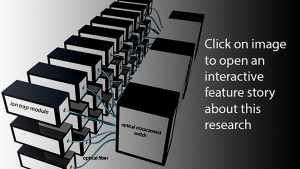Feb 26 2015
JQI researchers, under the direction of Christopher Monroe have demonstrated modular entanglement between two atomic systems, separated by one meter. Here, photons are the long distance information carriers entangling multiple qubit modules. Inside of a single module, quantized collective vibrations called phonons connect individual qubits.

In the latest result, one module contains two qubits and a second module houses a single qubit. This work was published in the journal Nature Physics, along with two related results that appeared in the Physical Review journals.
The two-by-one qubit entanglement is an experimental result that follows the theoretical design by Monroe and collaborators on building a modular universal quantum computer, published earlier in 2014. This group is pursuing a modular quantum computer architecture that promises scalability to much larger numbers of qubits. The components of this architecture have individually been tested and are available, making it a practical approach. Previously, the authors presented expected performance and scaling calculations, demonstrating that their architecture is not only viable, but in some ways, preferable when compared to related schemes...Read more about this research in an interactive feature story.
Modular Scalable Quantum Computing with Atomic Ions